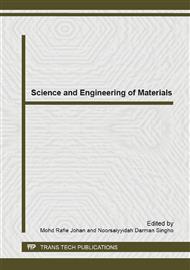p.217
p.224
p.228
p.235
p.240
p.244
p.248
p.252
p.259
Effects of Complexing Agent Concentration and Bath pH on Electroless Nickel Deposition for Tungsten Carbide Powders
Abstract:
An elemental nickel (Ni) or cobalt (Co) is typically introduced to tungsten carbide (WC) prior to powder injection moulding process (PIM) for hard metal fabrication to enhance toughness and tool life. Mixing of powders is normally practiced, although it requires a long processing time for homogeneous mixing. In this study, as an alternative method, an addition of Ni via the electroless deposition method is investigated. The key process parameters, including the concentration of the complexing agent, namely sodium citrate, and bath pH, are systematically examined in relation to deposition rate and deposits size, microstructure, and chemical compositions. As the bath pH is increased to higher alkalinity of 10 and the Ni ion to complexing agent mole ratio is controlled under 1:1, a stable electroless nickel solution and a relatively high deposition rate with about 15% weight gain for 1 hour deposition duration are achieved. The phosphorus (P) content, obtained in the range of 5-9 wt%, is largely influenced by the bath pH. While a rapid deposition rate is associated with preferentially deposition of Ni on pre-deposited Ni sites, a low to moderately high deposition rate results in more uniform incorporation of Ni-P alloys in WC powder mixture.
Info:
Periodical:
Pages:
240-243
Citation:
Online since:
June 2014
Keywords:
Price:
Сopyright:
© 2014 Trans Tech Publications Ltd. All Rights Reserved
Share:
Citation:


